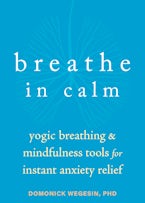By Domonick Wegesin, PhD, author of Breathe In Calm
After a year and a half of remaining pretty isolated, I made my first foray into Costco this week. I used to enjoy shopping there. But on this trip, I started feeling anxious as soon as I walked in. It seemed like the crowd got thicker as I moved down the first aisle, and I noticed myself strategically trying to dodge all the other shoppers, maintaining as much COVID-safe space between us as possible. Even before I had the first item in my cart, I started to lose track of what I was looking for and noticed that my grip on the cart had tightened. I recognized the mental confusion and muscle tension as signals of mounting anxiety, so I steered into a less populated aisle and started to take slow, deep breaths. Within a minute, I was feeling calmer and clearer, and was able to get back to my list.
Even after years of practicing and teaching, I continued to be amazed at how such a simple breathing technique can impact how you feel.
How to Slow Your Anxiety Roll
There are many breathing techniques that will help you calm down. The easiest place to start is with belly breathing, which helps you to slow and deepen your breath. Start by sitting in a chair, lean forward, and place your forearms on your lap. Let your fingers rest on your belly. Notice your belly expanding as you breathe in, and retracting as you breathe out. Feeling the breath in your belly also helps ground and embody you, whereas anxiety traps you in your thoughts and disassociates you from your body and surroundings.
You can accentuate the relaxation effect by adding a short pause after you exhale. If the pause is challenging, then leave it out for now and just stick with slow belly breaths.
You’ve undoubtedly read about similar breath techniques before, but in the moment of need, forget to use them. You’re not alone. When you’re in the middle of an anxious episode, your mind gets muddled, and it’s hard to plan and remember. Here are some tips that will help you put the breathing tool at the top of your anxiety toolbox.
1. Practice. Though the techniques are easy to learn, you’ll still benefit from practicing them regularly. If it’s an effort to remember how to do the technique, your brain may not be able to remember during an anxious episode. With regular practice, slow deep breathing becomes more automatic, so you can do it without a lot of mental effort. Frequent practice will also keep the breathing tool fresh in your mind, so you’re more likely to use it.
2. Practice at a time when you don’t feel overwhelmed. It helps to create an association between slow, deep breathing and feeling calm. If you only try the technique when you’re spinning in anxiety, it’ll be hard to do the technique well, and your struggle to make it happen may inadvertently make you more anxious.
3. Start small. Many people try to begin a self-care practice, but then give up on it when they find that they aren’t doing it consistently. We anxious folks tend to be perfectionistic, and hard on ourselves when we don’t live up to our expectations. Remember that any practice is good practice, even if it’s for a short time, and even if it’s inconsistent. Try to take just ten slow, deep breaths when you first wake up or before you get up from your breakfast. By scaling your practice to something that is more achievable, you’ll build confidence in your ability to show up for yourself.
4. Notice the effects. At the end of each practice session, try not to jump up immediately and race off to your next activity. Instead, take a minute to notice how you feel after a few slow, deep breaths. Being aware of the impact of breathing gives your mind more evidence for its efficacy. Over time, you will develop more trust that your breath practice will be there to help you when you need it.
5. Set an intention. Making a plan to use your breathing practice at times of need can take some of the burden off of you when you’re in the middle of an anxious episode. For example, “I’ll take five slow breaths whenever I notice myself feeling anxious.” Having a concrete plan in place makes it more likely to manifest when you need it.
Domonick Wegesin, PhD, conducted cognitive neuroscience research on the aging brain as a professor of neuropsychology in Columbia University’s department of neurology. He transitioned from academics into mind-body medicine, studying mindfulness-based stress reduction (MBSR) with Jon Kabat-Zinn and other senior teachers at the University of Massachusetts Medical Center. He currently teaches anxiety-reduction yoga classes and workshops in California.



 Part 2: What to Do When a Client Is Participating in Self-Judgment?
Part 2: What to Do When a Client Is Participating in Self-Judgment?